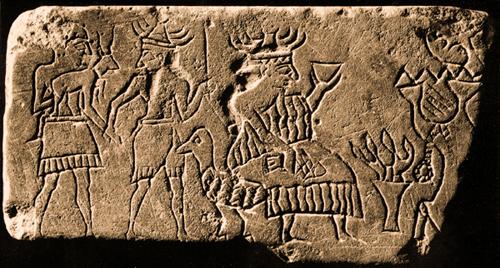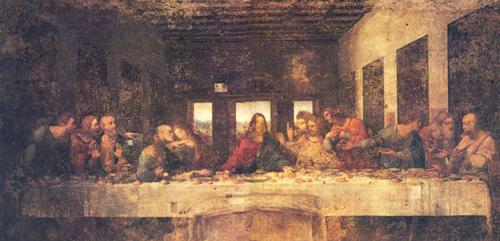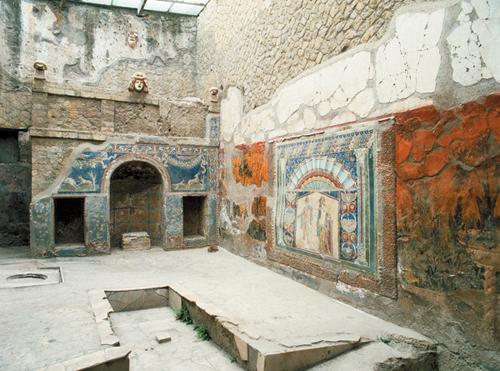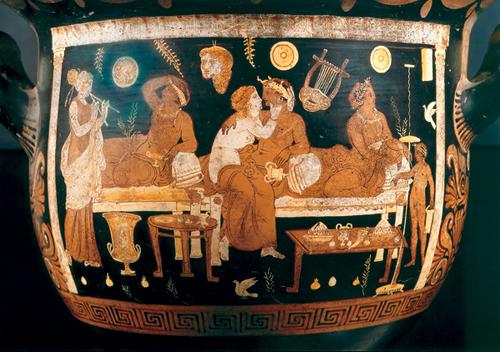A Feast for the Senses … and the Soul
Dorothy D. Resig
Source - http://www.biblicalarchaeology.org/daily/ancient-cultures/ancient-israel/a-feast-for-the-senses-and-the-soul/

Dating to the third millennium BC.E, this limestone plaque, discovered at Nippur depicts a well-sated goddess (center) holding a cup in one hand and a fish in the other as she relaxes on her duck-shaped throne. Behind her a male figure leads a worshiper, who is taking a small horned animal to the goddess. Photo courtesy of the University of Pennsylvania Museum (NEG S8-21978).
Few activities in life are as seemingly mundane yet vitally important as eating. Food is one of the bare necessities of life, and everyone—man or woman, young or old, king or servant—must eat. Thus it is perhaps not so surprising that many of the Biblical stories are set within the context of a meal. From the Hebrew Bible’s accounts of the food Abraham prepares for his divine visitors (Genesis 18:1–8), the stew with which Jacob deceives his aged father, Isaac (Genesis 27), and the all-important Passover meal (Exodus 12) to the New Testament’s miraculous wedding feast at Cana (John 2:1–11), the celebration for the return of the prodigal son (Luke 15:11–32), and even the Last Supper (Matthew 26; Mark 14; Luke 22; John 13), the Biblical texts provide countless examples of how ancient life was centered around meals. Ritual feasts and banquets in the Biblical world and beyond were particularly important occasions for showing devotion to a deity, solidifying social relationships and ranks, as well as teaching lessons.
In antiquity, even the gods had to eat. Temple officials in ancient Babylon and Egypt were tasked with the daily feeding of their deities. The statues of these deities were more than just depictions for their worshipers; they were themselves divine, and they needed to be fed, bathed, clothed and cared for. An elaborate ritual known as the Opening of the Mouth transformed manmade cult statues into “living” deities.1 The ritual included offering choice meats, honey, fruit and beer for the god’s statue to eat and drink, and even water to wash with after the meal.
In the religious practice of ancient Babylon and Egypt, the gods depended on their worshipers to provide sustenance. Thus in the Book of Zephaniah, the prophet warns that “The Lord will be against them; he will shrivel all the gods of the earth” (Zephaniah 2:11). The root of the Hebrew word translated as “shrivel” means “to make lean” or “to famish,” suggesting that Yahweh could cause rival deities to starve by cutting off their supply of food and drink.
The Israelites, too, made offerings of food and drink to their god, but since Yahweh was not represented by a statue or in any visual form, these sacrifices were burnt up or poured out on the altar. The Book of Numbers records the precise offerings of meat, grain and drink that were required by God twice each day, and more on the Sabbath and Passover festivals (Numbers 28).
Ritual feasts and banquets proved to be important social and political tools throughout Israel’s history. This was especially true in the early years of the Israelite monarchy. As one scholar has noted, “The king’s table was very important for creating and maintaining political support amongst the emerging elite. To be admitted to the table would have been an important marker of social status and influence.”2Thus was David invited to dine at Saul’s table (1 Samuel 20), and later David invites Uriah the Hittite to eat and drink at his own table in an attempt to cover the king’s affair with Uriah’s wife Bathsheba (2 Samuel 11). According to the Bible, King Solomon’s daily provisions from the district governors of flour, grain, meat and fowl (1 Kings 4:22–23, 26–28) were on a scale large enough to provide sumptuous meals for thousands of people. Likewise, lavish Persian feasts feature prominently at important points in the Book of Esther (1:11, 2:18, 5:4–8, 7:1–8, 9:18–23).3

The Last Supper by Leonardo da Vinci (1495-1498) depicts a Western European dining style instead of the reclining position that was common at Greco-Roman banquets of the ancient world. Art Resource, NY.
In later Judaism, meals had become familiar expressions of common identity, social unity and communal celebration.4 The community associated with the Dead Sea Scrolls came together at banquets, as did the Pharisees with others of their kind to partake of pure food and company. Even the weekly Sabbath meal was an occasion for families to come together and enjoy a night of festive fellowship unique to their own heritage.
So great were these celebratory communal meals that the afterlife came to be viewed as a great banquet at the end of time.5 The Hebrew Bible and extrabiblical Jewish writings describe the great messianic feast on the mountain of the Lord: “On this mountain the Lord of hosts will make for all peoples a feast of rich food, a feast of well-matured wines” (Isaiah 25:6ff.). It will be an “unfailing table” (4 Ezra 9:19) where “the righteous and elect ones…shall eat and rest and rise with that Son of Man forever and ever” (1 Enoch 62:12–14). This theme was later picked up by the authors of the New Testament.
Perhaps the oldest and most important feast celebrated by the Israelites and later by Jews is the Passover. With its roots in the Exodus account, the original feast consisted of a sacrificial lamb, bitter herbs and unleavened bread eaten by each family at home (Exodus 12). The blood of the lamb was brushed on the doorposts so that the angel of the Lord would spare the lives of each Israelite household. After the Passover, the next seven days constituted the Feast of Unleavened Bread. (Today both of these feasts are celebrated together under the name Passover.)
Under the Israelite monarchy and the establishment of the Temple in Jerusalem, the sacrifice and celebration of Passover became a centralized affair. It was now a national pilgrimage festival, bringing families to Jerusalem from all over Israel.6 The sacrificial lambs—still a crucial part of the feast’s observance—were brought to the Temple to be slaughtered and offered by the priests. Families who were able ate the Passover meal together there in Jerusalem.
Jews who could not make the pilgrimage to Jerusalem to offer the Passover sacrifice were still able to recognize the holiday by holding a special meal, discussing the significance of the day and observing the Feast of Unleavened Bread. After the destruction of the Temple by the Romans in 70 C.E., the traditional Passover celebration evolved to look more like this feast. The sacrifice of the lamb was no longer central without the priests and a Temple. The rabbis of the Mishnah (which was edited around 200 C.E.) elevated the non-sacrificial aspects of the feast—including the unleavened bread and bitter herbs—to allow for continued observance. Thus, the Passover seder was born. This structured meal of special foods, questions, teaching and singing—now located once again entirely in the domestic sphere—is still the central feature of Jewish Passover celebrations today.

This lavishly decorated triclinium was part of a Roman home in Herculaneum. Corbis
Some have speculated that the Last Supper, recounted in some form in all four of the Gospels, might have been a Passover seder. However, this is clearly not the case in the Gospel of John. For theological reasons the author put the Last Supper before the Passover feast (John 13:1); Jesus is killed at the same moment the lambs are sacrificed in the Temple—in effect making him the new Passover sacrifice (John 19:28–37). In Matthew, Mark and Luke’s gospels, the Last Supper is explicitly identified as the Passover meal (Matthew 26:17; Mark 14:12; Luke 22:7), but since Jesus and his disciples were celebrating in Jerusalem, decades before the destruction of the Temple, it would not yet have taken the form of a seder. Their feast was a traditional sacrificial Passover meal.
These meals did not develop in a vacuum, however. Just as the early Israelites had adopted the practice of offering food and drink to their god from their ancient Near Eastern neighbors, so too did later Passover feasts and seders (including the Last Supper) take on the form of traditional Greco-Roman banquets, albeit with their own particular Jewish influences and meaning.
A typical Greco-Roman feast featured diners reclining on couches—propped up on their left elbows—around a central table or a few smaller tables in a dining room (called an andron in Greek and tricliniumor stibadium in Latin).7 Among the Greeks, usually only men reclined at these banquets; respectable women (such as the wives of the diners), if present, sat upright at the foot of the couches where the men reclined (cf. Luke 10:39) and usually left before the less wholesome entertainment of the evening began (which often included less-respectable women). Roman women, however, often attended banquets and reclined with the men. Food was generally served in a few communal dishes, in which diners would dip their bread or eat with their hands. Wine flowed freely and was served in bowls. Music, poetry, dancers, debate and even sexual play were all common forms of entertainment at these events.

The dinner entertainment at Greek and Roman banquets often included prostitutes and musicians, both shown in the banquet scene decorating a Greek red figure vase, probably made in southern Italy or Sicily in the fifth or fourth century B.C.E. Scala/Art Resource, NY.
PART. 2